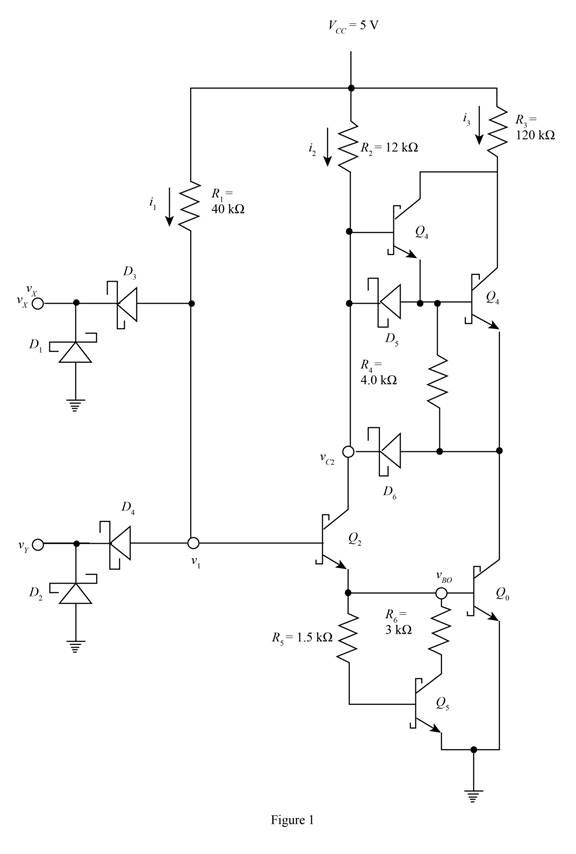
Concept explainers
(a)
The base and the collector current in each of the transistor. Also, the power dissipation in the gate.
(a)
Answer to Problem 17.12EP
The currents in the transistors are,
Explanation of Solution
Calculation:
The given diagram is shown in Figure 1

The expression to determine the value of the voltage
Substitute
The expression to determine the value of the current
Substitute
The conversion from
The conversion from
The second transistor and the output transistor are in cut off region and the current in the circuit are given by,
The expression for the value of the collector current and the base current of the output transistor is given by,
The expression for the base and the collector current of the third and the fourth transistor are given by,
The expression for the power dissipated in the circuit is given by,
Substitute
Conclusion:
Therefore, the currents in the transistors are,
(b)
The base and the collector current in each of the transistor. Also, the power dissipation in the gate.
(b)
Answer to Problem 17.12EP
The currents in the transistors are,
Explanation of Solution
Calculation:
The expression to determine the value of the voltage
Substitute
The expression for the voltage
Substitute
The expression to determine the value of the current
Substitute
The expression to determine the value of the current
Substitute
The conversion from
The conversion from
The expression for the base current of the second transistor is given by,
Substitute
The expression for the collector current of the second transistor is given by,
Substitute
The fifth transistor is in the cut off region and the current in the circuit are given by,
The expression for the value of the collector current of output transistor is given by,
Substitute
The expression for the base and the collector current of the third and the fourth transistor are given by,
The expression for the power dissipated in the circuit is given by,
Substitute
The conversion from
The conversion from
Conclusion:
Therefore, the currents in the transistors are,
Want to see more full solutions like this?
Chapter 17 Solutions
Microelectronics: Circuit Analysis and Design
- A Three-phase, 12 pole, Y-connected alternator has 108 slots and 14 conductors per slot. The windings are (5/6 th) pitched. The flux per pole is 57 mWb distributed sinusoidally over the pole. If the machine runs at 500 r.p.m., determine the following: (a) The frequency of the generated e.m.f., (b) The distribution factor, (c) The pitch factor, and (d) The phase and line values of the generated e.m.f.?arrow_forwardTwo 3-ph, 6.6 kV, Y-connected, alternators supply a load of 3000 kW at 0.8 p.f. lagging. The synchronou impedance per phase of machine A is (0.5+110) and that of machine B is (0.4 +J12) . The excitation of machine A adjusted so that it delivers 150 A. The load is shared equally between the machines. Determine the armature curre p.f., induced e.m.f., and load angle of each machine?arrow_forwardName the circuit below? The output voltage is initially zero and the pulse width is 200 μs. Find the Vout and draw the output waveform? +2.5 V V 247 -2.5 V C 0.01 F Ri W 10 ΚΩarrow_forward
- Please work outarrow_forwardFind Vfinal when Vs up and Vs V. Which LED will light in each case? Red or Green? Justify your answers. Fill the table below. Vs 8 ΚΩ Vos Χρι + 3 ΚΩ www 6 ΚΩ ww 4 ΚΩ Yo www Vo Vec-12 V Nol V final Vm w 3 ΚΩ 5 V 38 ΚΩ R= 1 kQ V -12 V Red LED Green LED Vs Vo Vfinal Which LED is ON? Varrow_forwardCircuits help please solve and explain. Question in images providedarrow_forward
- + V 6.2 A 1.2 A S R 4 Ω Find the source voltage Vs 0.8 Aarrow_forwardDetermine i(t) for t≥ 0 given that the circuit below had been in steady state for a long time prior to t = 0. Also, I₁ = 1 5 A, R₁ =22, R2 =10 Q2, R3 = 32, R4 =7 2, and L=0.15 H. Also fill the table. m L ww R2 t = 0 R₁ 29 R3 R4 Time 0 iL(t) 0 8arrow_forwardPlease help explain this problemarrow_forward
- + P = 16 W w w P = 8 W I R₁ R2 E = RT=322 1- Determine R1, R2, E ΙΩarrow_forward+ 30 V = - 20 V + R 2- Use KVL to find the voltage V - V + + 8 Varrow_forwardFind the Thévenin equivalent circuit for the portions of the networks in Figure external to the elements between points a and b. a R₁ 2002 I = 0.1 A 0° Xc : 32 Ω R2 = 6802 20 Ω фъarrow_forward
 Delmar's Standard Textbook Of ElectricityElectrical EngineeringISBN:9781337900348Author:Stephen L. HermanPublisher:Cengage Learning
Delmar's Standard Textbook Of ElectricityElectrical EngineeringISBN:9781337900348Author:Stephen L. HermanPublisher:Cengage Learning
